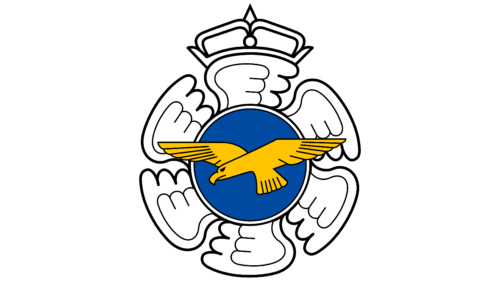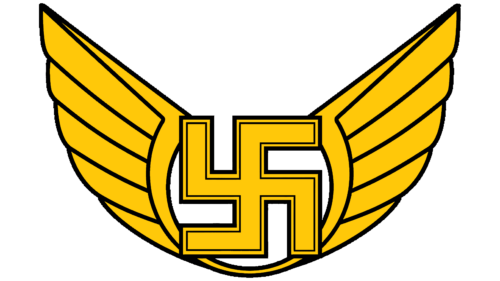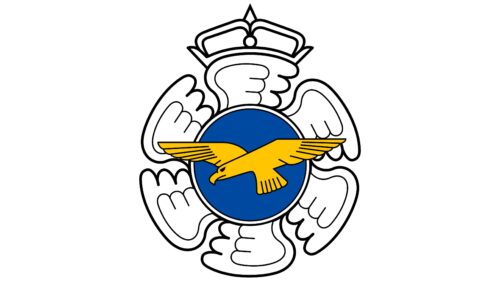The emblem of the Finnish Air Force is a symbol of constancy and strength. It shows the constant patrolling of the borders and the readiness to defend them. The emblem uses the national colors of the country as a symbol of loyalty and faithfulness.
The emblem of the Finnish Air Force was redesigned after World War II, as the former symbol, the blue swastika, fell under prohibition. Today, the updated emblem is a neutral symbol, a far cry from the controversial insignia that replaced it.
The current emblem shows a golden eagle caught in flight against a blue circle framed by six white wings. The bird, with its piercing gaze staring downward as if ready to snatch its prey, epitomizes fighting spirit. This image metaphorically represents bravery and readiness for battle, two qualities inherent in any air force.
Finnish Air Force: Brand overview
The Finnish Air Force’s origins can be traced back to March 6, 1918, when the newly independent nation established an aviation unit within its army. Initially, the fledgling air force possessed only a handful of captured Russian planes from the Great War. The 1920s saw the gradual development and modernization of Finland’s aerial capabilities. Foreign instructors were brought in to train flight personnel, and new aircraft were procured, primarily from France and the United Kingdom. By the decade’s end, the fleet had grown to include Bristol Bulldog fighters, Breguet 14 bombers, and several other types.
The 1930s marked a period of further strengthening for the new aviation unit. The backbone of the fighter fleet consisted of Dutch Fokker D.XXIs, while British Bristol Blenheim bombers were delivered to the country. The Finnish government placed great importance on developing its military aviation, believing it could play a crucial role in national defense. The unit’s mettle was tested during the Soviet-Finnish “Winter War” of 1939-1940. Despite the Soviet Air Force’s overwhelming numerical superiority, Finnish pilots demonstrated exceptional skill and courage, achieving several impressive victories. The Fokker D.XXI fighters, in particular, distinguished themselves, successfully countering Soviet bombers and holding their own against more modern fighters. After the “Winter War,” Finland strengthened its aviation unit further.
1940-1941, German Messerschmitt Bf 109 fighters and Junkers Ju 88 bombers were commissioned, significantly enhancing the unit’s combat power. These enhancements proved useful during the subsequent “Continuation War” against the USSR from 1941 to 1944, during which Finland fought alongside Nazi Germany. Finnish pilots again excelled, achieving numerous aerial victories. Following Finland’s withdrawal from World War II in 1944, its armed forces, including aviation, were significantly restricted according to the terms of the armistice. However, in the late 1940s, the aviation unit’s gradual restoration and modernization began. Finland received aircraft from Western countries (mainly the United Kingdom and Sweden) and the USSR, including de Havilland Vampire jets, Saab J-29 Tunnans, and later, MiG-21s and Saab 35 Drakens.
The 1960s and 1970s saw continued strengthening of the unit’s capabilities. The country maintained a policy of non-alignment and sought to balance relations with the USSR and NATO. During this period, Swedish Saab 35 Draken and Saab 37 Viggen fighters, as well as Soviet MiG-21bis aircraft, were introduced. Finland developed its air defense system and military airfield infrastructure. After the Cold War ended and the Soviet Union collapsed in 1991, Finland began more active military cooperation with Western countries.
In the 1990s and 2000s, the aviation unit participated in several international exercises and peacekeeping operations under the auspices of the UN and EU. The fleet primarily consisted of American F/A-18 Hornets, purchased in the 1990s and modernized in the 2000s. In the 2010s, the unit continued its development and integration with Western partners. The country actively participated in NATO exercises such as “Trident Juncture” and “Arctic Challenge,” despite not being a formal alliance member. Finnish pilots consistently demonstrated high skill in international competitions.
In recent years, Finland began selecting a new fighter to replace the aging F/A-18 Hornets. After thorough analysis and testing, the Finnish government announced in December 2021 its intention to acquire 64 American fifth-generation F-35 Lightning II fighters. Deliveries of the new aircraft are expected to begin in the second half of the 2020s.
Meaning and History
The Finnish Air Force was founded in 1918. It is logical to assume that it was then that their first emblem appeared. The image carried the idea of law and order. However, after Nazi Germany, the image of the swastika became negatively perceived throughout the world, which was the reason for the change of visual symbols. Each sign traces the idea of flight, which is conveyed by the presence of wings. Round shapes indicate the slimness of the ranks of troops and the aerodynamic properties of airplanes.
What is the Finnish Air Force?
It is an aviation unit of the Finnish Army, founded in 1918 after the separation from the Russian Empire. The main fighter aircraft of the Air Force are 64 American F/A-18C/D Hornets, which are planned to be completely replaced by Lockheed Martin F-35A Lightning II by 2030.
The Finnish Air Force is the country’s defense force, ensuring the security of the country’s airspace. They have more than 3,000 active servicemen and almost 38,000 servicemen in reserve. They are divided into three groups based in Rovaniemi, Tampere, and Kuopio-Rissala.
Old
The first emblem of the Finnish Air Force depicted a swastika and a pair of wings. In addition to symbolizing the cycle of day and night, winter and summer, and life and death, the swastika stands for the laws that maintain order in the world. These forces are tasked with preserving peace and the natural flow of life in the country, which is why this symbol was chosen.
According to Finnish legend, the swastika first appeared on an airplane presented by Count Erich von Rosen to the troops of the Republic of Finland and symbolized good luck. This image was later adopted as part of the coat of arms by Order No. 26 of Carl Gustav Emil Mannerheim, Chief of the General Staff. The early flag of the Republic complemented the emblem.
Count Rosen was not originally associated with Nazism, but he later became the son-in-law of Hermann Göring, Hitler’s friend and leader of the National Socialist movement. Interestingly, the image of the swastika is preserved on the country’s presidential flag.
The two wings in the emblem surround the image, symbolizing flight. The feathers are raised upward, signifying protection. Citizens have nothing to worry about. The powers that be are protecting them, watching over everything from above.
The curved lines of the swastika resemble the propellers of an airplane, and the wings of a bird resemble the wings of a fighter jet.
Interestingly, the image of wings corresponds to many emblems. For example, the emblem of Aeroflot, the badge on the cap of the Russian Air Force, the eagle of the Weimar Republic, and later Nazi Germany. This suggests that this symbol, like the swastika, has common roots in the past.
The color of the first distinctive sign was blue. Later, it was replaced by gold, which looked more spectacular on fuselages and caps. However, blue shades are also used for the livery of airplanes.
After World War II, the Finnish Air Force stopped depicting the swastika on its planes in order not to associate the country with the crimes of Nazi Germany.
New
The basis of the new Air Force emblem after 1944 was a blue circle with six pairs of wings arranged in the direction of the wheel’s rotation. The blue circle with a white border was firmly associated with Finland. It was attached to the caps of military commanders, and the blue and white colors are part of the country’s flag. The first color symbolizes Finnish lakes, and the second symbolizes snow. However, in the context of the Finnish Air Force, they also speak of the sky and clouds.
The sixfold repetition of the wings echoes the motto of quality and strength. Above the upper wing is a cap or crown, indicating the elite status of the troops.
In the center of the entire figure flies a golden eagle. This bird is common in the Northern Hemisphere, especially in Norway and Finland, and is associated with country and flight. The golden eagle is a symbol of strength. It is a strong raptor with a wingspan of up to 2.5 meters. Air Force warriors vigilantly guard the country’s borders, as they have eagle-like sharp eyesight and enough strength to repel the enemy.
Font and Colors
The emblem of the Finnish Air Force is a prototype of constancy and strength. It demonstrates the constant guarding of borders and readiness to defend them. The emblem uses the national colors of the country, symbolizing devotion and loyalty.
The main colors of the sign – are blue, white, and gold. These shades perfectly echo the heraldic symbols of the country.
- Blue – the expanse of the sky, where fighter jets soar, the waters of lakes. The color of professionals who know how to follow commands.
- White – cold snow and airy clouds. The color represents bravery and honesty, which distinguishes warriors.
- Gold is the color of awards. A symbol of nobility and victories.
Interestingly, the symbol of the Finnish Air Force does not contain any inscriptions, as the drawn emblem is better perceived on a flying airplane.
Finnish Air Force color codes
| Golden Poppy | Hex color: | #ffc500 |
|---|---|---|
| RGB: | 255 197 0 | |
| CMYK: | 0 23 100 0 | |
| Pantone: | PMS 7549 C |
| Cobalt Blue | Hex color: | #004aa2 |
|---|---|---|
| RGB: | 0 74 162 | |
| CMYK: | 100 54 0 36 | |
| Pantone: | PMS 661 C |
| Black | Hex color: | #000000 |
|---|---|---|
| RGB: | 0 0 0 | |
| CMYK: | 0 0 0 100 | |
| Pantone: | PMS Process Black C |






